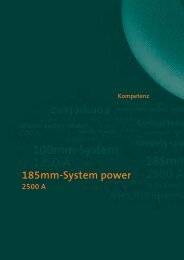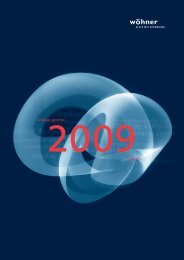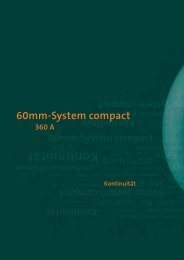phb2013_complete_en.pdf [18.3 MB] - Wöhner
phb2013_complete_en.pdf [18.3 MB] - Wöhner
phb2013_complete_en.pdf [18.3 MB] - Wöhner
You also want an ePaper? Increase the reach of your titles
YUMPU automatically turns print PDFs into web optimized ePapers that Google loves.
12 Made in Germany: Inv<strong>en</strong>ting is our str<strong>en</strong>gth<br />
MADE IN GERMANY<br />
INVENTING<br />
IS OUR<br />
STRENGTH<br />
In terms of the quantity of technical innovations<br />
that Germany produces it is no<br />
longer a world leader. But the quality of<br />
new developm<strong>en</strong>ts is not determined<br />
solely by their quantity.<br />
A 19th c<strong>en</strong>tury critic of the motor car built<br />
by Carl B<strong>en</strong>z claimed that it was “too<br />
loud, too fast and too dangerous”. This is,<br />
of course, not true of the majority of<br />
newideas developed by German inv<strong>en</strong>tors.<br />
Most of the g<strong>en</strong>uinely pioneering innovations<br />
from Germany have succeeded<br />
because of their high quality, as did<br />
the motor car.<br />
Germans seem to have inherited the inv<strong>en</strong>tion<br />
g<strong>en</strong>e. But Germany is no longer the<br />
country with the most pat<strong>en</strong>ts registered<br />
each year, as the news magazine “Der<br />
Spiegel” discovered. In 2011 it was in fifth<br />
place behind China, the USA, Japan and<br />
South Korea. However, it is important to<br />
m<strong>en</strong>tion that the sheer volume of pat<strong>en</strong>ts<br />
says nothing about the quality of the new<br />
ideas and products.<br />
Ensuring that innovations from Germany<br />
are of high <strong>en</strong>ough quality to be successful<br />
on world markets requires constant effort.<br />
For example, in the <strong>en</strong>gineering industry,<br />
one of the cornerstones of the German<br />
economy, more than EUR 5 billion is invested<br />
every year in research and developm<strong>en</strong>t.<br />
Companies have no choice but to invest<br />
large sums if they want to continue to be<br />
able to offer innovative high-quality<br />
products and services in future.<br />
wöhnervision<br />
In order to maintain their position on the<br />
increasingly competitive global markets in<br />
the decades to come, German firms will<br />
have to continue sp<strong>en</strong>ding large amounts<br />
of money on research and developm<strong>en</strong>t.<br />
Ultimately, this is all about raising awar<strong>en</strong>ess<br />
among customers all over the world of<br />
the quality of goods that are “Made in Germany”.<br />
Purchasers need to be convinced<br />
that an exp<strong>en</strong>sive product from Germany is<br />
preferable to a cheaper alternative because<br />
of its quality. A longer service life, greater<br />
flexibility and improved sustainability are<br />
the argum<strong>en</strong>ts used and the result of corporate<br />
investm<strong>en</strong>t. All of this pays off for<br />
customers.<br />
One of the greatest German inv<strong>en</strong>tors of all<br />
time explained the credo behind the German<br />
desire to innovate: “I have always acted<br />
according to the principle that I would<br />
rather lose money than trust,” said Robert<br />
Bosch once. “The integrity of my promises,<br />
the belief in the value of my products and<br />
in my word of honour have always had a<br />
higher priority to me than a transitory profit.”<br />
That says it all.<br />
WÖHNER REFERENCES<br />
Innovation at Wöhner: in 2008 the CrossLink® Technology<br />
created by the in-house research and developm<strong>en</strong>t<br />
departm<strong>en</strong>t was launched on the market.<br />
CrossLink® Technology meets the highest standards<br />
of plant availability and personal safety.<br />
THE PRINTING PRESS<br />
Johannes Gut<strong>en</strong>berg, a goldsmith from<br />
Mainz, inv<strong>en</strong>ted the printing press<br />
with movable letters made of metal. This<br />
made it possible to produce books on<br />
an industrial scale and triggered a revolution<br />
in knowledge.<br />
Around 1450


![phb2013_complete_en.pdf [18.3 MB] - Wöhner](https://img.yumpu.com/12655320/14/500x640/phb2013-complete-enpdf-183-mb-wahner.jpg)









![phb2013_08_en.pdf [1.25 MB] - Wöhner](https://img.yumpu.com/12655318/1/184x260/phb2013-08-enpdf-125-mb-wahner.jpg?quality=85)



![phb2013_deu_05.pdf [4.32 MB] - Wöhner](https://img.yumpu.com/12655312/1/184x260/phb2013-deu-05pdf-432-mb-wahner.jpg?quality=85)